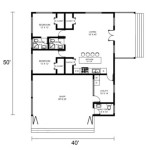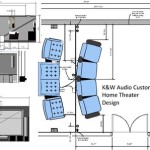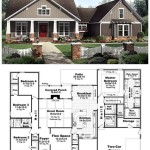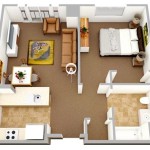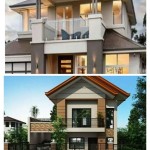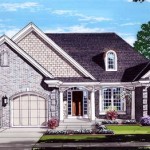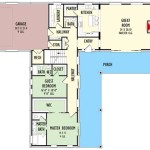No Dining Room House Plans: Rethinking the Traditional Home
The concept of "no dining room house plans" represents a significant shift in residential design, driven by evolving lifestyles and a desire for more flexible living spaces. Traditionally, the dining room served as a dedicated area for formal meals and gatherings. However, contemporary homeowners are increasingly prioritizing open-concept layouts, multifunctional spaces, and a more casual approach to dining. This article explores the factors contributing to the popularity of house plans without a designated dining room, the design considerations involved, and the alternative approaches to meal consumption and social interaction within these homes.
The rise of no dining room house plans is not simply a rejection of tradition but a pragmatic response to changing demographics, smaller family sizes, and a greater emphasis on efficiency and informality. Many modern families find that a formal dining room is rarely used, occupying valuable square footage that could be better allocated to other areas of the home. Furthermore, the increasing prevalence of takeout food, casual meals eaten in front of the television, and the desire for open-plan living have all contributed to the decline in the perceived necessity of a separate dining room.
Factors Driving the Popularity of No Dining Room House Plans
Several key factors are contributing to the growing demand for house plans that eliminate the traditional dining room. These factors include evolving lifestyles, space optimization, and the rise of open-concept designs.
Evolving Lifestyles: Modern life is often characterized by a fast-paced, informal approach to daily routines. Families are increasingly seeking homes that reflect this lifestyle, prioritizing comfort and convenience over formal rituals. The traditional dining room, with its emphasis on formal dinners and structured gatherings, can feel out of sync with this more relaxed approach. Many individuals and families prefer to eat casually in the kitchen, at a breakfast bar, or in a flexible living area. This shift in dining habits has directly impacted the demand for dedicated dining spaces, leading to the adoption of no dining room house plans.
Space Optimization: In many cases, particularly in urban areas or smaller homes, space is a premium. A dedicated dining room can occupy a significant portion of the house, especially if it is only used sporadically. Eliminating the dining room allows homeowners to reallocate this space to other more frequently used areas, such as larger kitchens, home offices, playrooms, or expanded living areas. This focus on space optimization makes no dining room house plans particularly appealing to those seeking to maximize the utility and efficiency of their homes.
The Rise of Open-Concept Designs: The open-concept layout, which integrates the kitchen, living room, and dining area into a single, flowing space, has become increasingly popular. This design style promotes social interaction and creates a more spacious and airy feel. In open-concept designs, the traditional dining room is often eliminated, with dining occurring at a kitchen island, breakfast bar, or a designated dining area that is integrated into the main living space. The emphasis on connectivity and flexibility inherent in open-concept designs aligns perfectly with the principles of no dining room house plans.
Design Considerations for Homes Without a Dining Room
Designing a home without a traditional dining room requires careful consideration of alternative dining spaces and the overall flow of the house. Key considerations include the integration of dining areas into other spaces, the provision of adequate seating, and the creation of a functional and aesthetically pleasing environment.
Integrating Dining Areas into Kitchens and Living Spaces: The most common approach in no dining room house plans is to integrate the dining area into the kitchen or living space. This can be achieved through the use of kitchen islands with seating, breakfast bars, or designated dining nooks within the living room. When integrating dining areas, it is crucial to consider the overall flow and functionality of the space. The dining area should be conveniently located near the kitchen for easy access to food and beverages, while also being comfortable and inviting for extended meals and gatherings. The design should also ensure that the transition between the kitchen, dining, and living areas is seamless and visually harmonious.
Provision of Adequate Seating: Even without a dedicated dining room, it is essential to provide adequate seating for family members and guests. This may involve a combination of bar stools, dining chairs, and comfortable seating options in the living area. The type and amount of seating should be carefully considered based on the size of the household, the frequency of guests, and the overall design aesthetic. For example, a large kitchen island with ample seating can serve as a primary dining area for everyday meals, while a smaller dining nook in the living room can be used for more intimate gatherings. The selection of appropriate seating options is crucial for creating a functional and comfortable dining experience.
Creating a Functional and Aesthetically Pleasing Environment: The dining area, whether integrated into the kitchen or living space, should be designed to be both functional and aesthetically pleasing. This involves selecting appropriate furniture, lighting, and decor that complement the overall design of the home. The lighting should be warm and inviting, creating a comfortable atmosphere for dining. The furniture should be durable and easy to clean, while also being aesthetically pleasing. The decor should be cohesive and reflect the personal style of the homeowner. By carefully considering these factors, it is possible to create a dining area that is both functional and visually appealing, even in the absence of a traditional dining room.
Alternative Approaches to Meal Consumption and Social Interaction
Eliminating the formal dining room necessitates exploring alternative approaches to meal consumption and social interaction. These approaches focus on creating flexible, comfortable, and inviting spaces that cater to a variety of dining scenarios and social gatherings.
Embracing Casual Dining: No dining room house plans often promote a more casual approach to dining. This may involve eating meals at the kitchen island, in front of the television, or outdoors on the patio or deck. This casual approach can be particularly appealing to busy families who prioritize convenience and comfort over formal rituals. Embracing casual dining requires a shift in mindset, focusing on creating comfortable and inviting spaces that cater to a variety of dining scenarios. This may involve incorporating comfortable seating, durable surfaces, and easy-to-clean materials into the design. The emphasis is on creating a relaxed and informal atmosphere that encourages spontaneous meals and social interaction.
Utilizing Flexible Spaces: In many no dining room house plans, the living area is designed to be a flexible space that can be adapted for a variety of purposes, including dining. This may involve incorporating a large coffee table that can be used for casual meals, or a modular dining table that can be easily expanded for larger gatherings. The key is to create a space that is adaptable and can accommodate a range of activities. This requires careful consideration of furniture placement, lighting, and overall design. The flexible space should be comfortable and inviting, encouraging social interaction and accommodating a variety of dining scenarios.
Creating Outdoor Dining Areas: Many homeowners are increasingly incorporating outdoor dining areas into their no dining room house plans. This may involve creating a covered patio or deck with a dining table and chairs, or a more elaborate outdoor kitchen with a built-in grill and bar. Outdoor dining areas provide a pleasant alternative to indoor dining, particularly during warmer months. These areas encourage social interaction and provide a relaxed and informal setting for meals and gatherings. When designing an outdoor dining area, it is important to consider factors such as weather protection, privacy, and lighting. The area should be comfortable and inviting, providing a seamless transition between indoor and outdoor living.
Ultimately, no dining room house plans represent a departure from traditional residential design, prioritizing flexibility, efficiency, and a more casual approach to dining. By carefully considering the design implications and exploring alternative approaches to meal consumption and social interaction, homeowners can create homes that are both functional and aesthetically pleasing, reflecting their individual lifestyles and preferences.

12 House Plans Without Formal Dining Room Ideas Floor Plan Design

Open Floor Plan No Dining Room 4 Bedroom

Open Concept Floor Plans Without Formal Living Rooms Or Dining Rm

Floorplan No Formal Dining

Minimalist Floor Plans With Porches Houseplans Blog Com

Traditional Homes With Closed Floor Plans Blog Eplans Com

Plan 020h 0284 The House

Your Open Concept Floor Plan Here S How To Fix It Laurel Home

Country House Plan 053 02296

Great Floor Plan No Formal Living Or Dining Room First Each Bedroom Has Its Own Bathroom Big Showers

